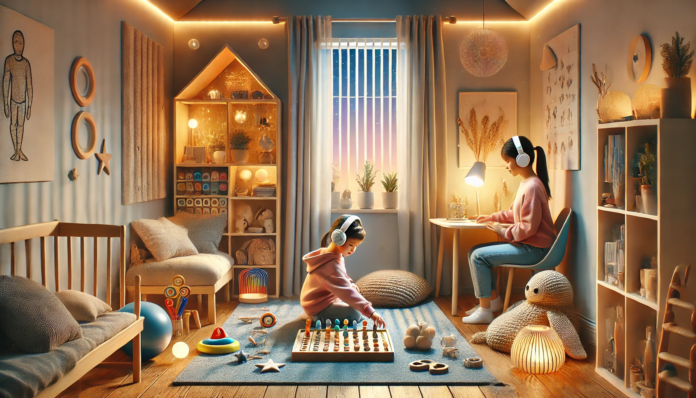Many individuals with autism spectrum disorder (ASD) and attention-deficit/hyperactivity disorder (ADHD) experience the world differently through their senses. These sensory processing differences can significantly impact daily functioning, from causing discomfort in certain environments to influencing behavior and attention. Understanding these sensory experiences is crucial for creating supportive environments and developing effective coping strategies.
Understanding Sensory Processing Differences
Sensory processing refers to how the brain receives, interprets, and responds to sensory information from the environment. For those with autism or ADHD, this process often works differently:
Autism: Many autistic individuals experience hypersensitivity (over-responsiveness) or hyposensitivity (under-responsiveness) to sensory input. Some may be overwhelmed by bright lights, loud sounds, or certain textures, while others might seek out intense sensory experiences.
ADHD: People with ADHD often experience sensory processing challenges related to filtering relevant from irrelevant stimuli. They may be easily distracted by background noises or visual stimuli that others can tune out, or they might seek sensory stimulation to maintain focus and attention.
These differences aren’t flaws—they’re simply variations in how the nervous system works. However, they can create challenges in environments designed for neurotypical sensory processing.
Common Sensory Challenges
Visual Processing
- Sensitivity to fluorescent lighting or bright lights
- Difficulty with visual clutter or busy environments
- Challenges with certain visual patterns or movements
Auditory Processing
- Difficulty filtering background noise
- Sensitivity to loud, unexpected, or particular sounds
- Trouble following verbal instructions in noisy environments
Tactile Processing
- Discomfort with certain clothing textures or tags
- Sensitivity to light touch or unexpected physical contact
- Seeking deep pressure or weighted sensations
Other Sensory Domains
- Sensitivities to smells or tastes
- Challenges with proprioception (body awareness) and vestibular sensing (balance and movement)
- Difficulties with interoception (internal body sensations like hunger or needing the bathroom)
Strategies for Sensory Comfort and Regulation
Creating Sensory-Friendly Spaces
At Home:
- Use soft, adjustable lighting instead of harsh overhead lights
- Create quiet zones with minimal visual distractions
- Use sound-absorbing materials like rugs, curtains, and soft furniture
- Organize spaces to reduce visual clutter
- Designate a calming retreat space for overwhelm
In Schools and Workplaces:
- Provide quiet workspaces or noise-canceling headphones
- Allow for movement breaks and flexible seating options
- Consider alternatives to fluorescent lighting
- Permit sensory tools at desks and workstations
- Create predictable routines with warnings before transitions
Personal Regulation Strategies
For Overstimulation:
- Deep pressure activities: weighted blankets, compression clothing
- Breathing exercises and mindfulness techniques
- Noise-canceling headphones or earplugs
- Sunglasses for light sensitivity
- Taking scheduled sensory breaks
For Understimulation:
- Movement breaks: jumping, spinning, rocking
- Fidget tools that provide appropriate sensory input
- Chewable jewelry or tools for oral sensory needs
- Textured objects for tactile stimulation
- Exercise routines that incorporate proprioceptive input
Adaptive Tools and Resources
Sensory Tools:
- Noise-canceling headphones
- Sunglasses or colored overlays for visual sensitivities
- Weighted items (blankets, vests, lap pads)
- Variety of fidget tools for different sensory needs
- Chewable jewelry or tools
Technology Supports:
- Sound level meters and apps
- Lighting adjustment apps
- Visual schedules and timers
- Sensory mapping apps to identify challenging environments
Building Sensory Awareness and Advocacy
Teaching individuals with sensory processing differences to recognize their own sensory needs is empowering. This self-awareness allows for:
- Identifying personal triggers before they lead to overwhelm
- Communicating needs clearly to others
- Developing personalized coping strategies
- Self-advocating in different environments
For children, using sensory diaries, emotion charts, and regular check-ins can help develop this awareness. For adults, mindfulness practices and body scanning techniques can enhance sensory self-awareness.
Supporting Others with Sensory Processing Differences
If you’re a parent, teacher, employer, or friend of someone with sensory processing differences:
- Listen without judgment to their descriptions of sensory experiences
- Believe their experiences, even if you don’t share them
- Make reasonable accommodations when requested
- Learn about their specific sensory profile
- Recognize that sensory needs may change day-to-day
When to Seek Professional Support
Working with occupational therapists who specialize in sensory integration can provide tailored strategies and interventions. These professionals can:
- Assess specific sensory processing patterns
- Develop personalized sensory diets (scheduled activities to meet sensory needs)
- Recommend appropriate adaptive tools
- Guide families, schools, and workplaces in creating supportive environments
Understanding and accommodating sensory processing differences is essential for creating inclusive environments where individuals with autism and ADHD can thrive. By implementing sensory-friendly strategies and supporting self-regulation, we can reduce barriers and enhance comfort, focus, and well-being. Remember that each person’s sensory profile is unique—what works for one person may not work for another. The goal is to find personalized approaches that support regulation and comfort in a world that can sometimes be overwhelming.
